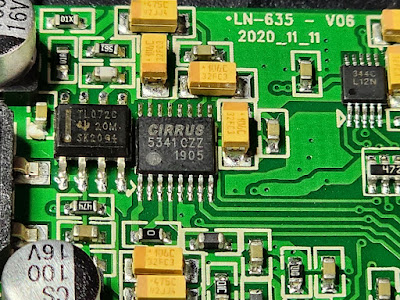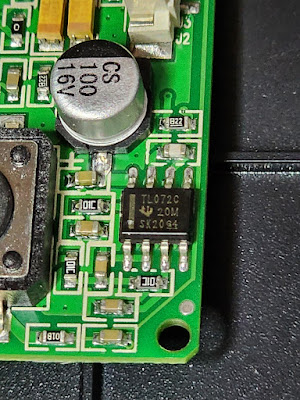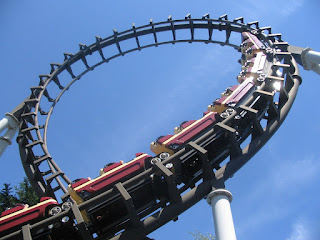J.P.'s Gear Review v2.0 - Ep. 9 - The cheapest pedal on Amazon, April-May 2023 Edition
I have a few things going on right now, and writing reviews and recording demos is not my top priority. Since I haven't published anything in a while, here is a short-ish one. -J.P.
Why the roller coaster header image? Well, I couldn't find a suitable royalty-free image for an infinite loop, and that was the closest thing that made sense.
As you might have guessed already, the cheapest pedal I found on Amazon this past April is... a looper! Without further ado, let's get right to the review.
ammoon Loop Station
It's one of those super-small "nano" pedals. In terms of dimensions, it is 3.6cm by 7.5cm by 2.6cm (width, length, height; that's 1¼" by 2¾" by 1" if metric is not your thing). It's smaller than my MXR Phase 95, which is a "regular nano" size (not to be confused by Electro-Harmonix concept of "nano", which only means "regular 1590B enclosure" instead of "1970's vintage big box enclosures").
It's a very simple pedal:
- One ¼" input
- One ¼" output
- One 2.1mm Boss-style, center negative DC jack
- A 3-position toggle
- A single Level knob
- One clicky momentary footswitch (well, sort of...)
- One SD card slot.
It requires a power adapter that can provide at least 120mA of current. The manual also states that "When the gear switch is switched to reverse play mode, the product does not turn on when powered on"...
With the incredible price tag of 11.99$CAD for the grey version (or 18.99$CAD if you want it blue), it comes with a 1GB SD card to export your loops, and it can loop 10 minutes of recording.
 |
| Amazon listing at the time of purchase, in all its glory. |
Let's take a minute and appreciate the marketing these guys put forth. First, the brand name mentioned on the Amazon listing is "Btuty", and I received an "ammoon"-branded unit. I would say this is a win since at least I've heard of the ammoon brand. Below are the images that were in the listing, and I will let you appreciate them:
Beside the strange phrasing and choice of words, the image composition is something. Notice that the unit displayed in the marketing material has no branding whatsoever. ammoon, being a OEM manufacturer, will slap your logo on anything. I suppose it is the vanilla marketing material they offer when you buy a few pallets of their stuff.
Unboxing and checking the insides
The unboxing itself went exactly as you'd expect. There's a manual, a 50% off VIP card (in which I learned I'm their "lovely" and I'm a little creeped out...), the pedal comfortably cradled in foam, and a USB adapter for the SD card.
 |
| Bottom side has the manufacturer's information. |
 |
| The manual's translation is interesting. |
 |
| I'm not sure how I feel about being called their "lovely". |
 |
| Compared to an EHX "nano" pedal, the Loop Station has a much smaller footprint. |
The internals of a pedal of this price and size needs to be investigated, so of course I opened it. In order to do so, you need to remove the two rubber feet to uncover the four screws and remove the nut that holds the toggle switch in place. It is surprisingly well made for such a cheap product. The input and output jacks are wired with a 4-wire connector, which makes removing the PCB assembly quite easy since you don't have to unscrew and remove everything.
The circuit is definitely some sort of System-On-Chip or programmable microcontroller. Which one, though, it's hard to tell since the largest chip only has a marking of "6a". I'll hazard a guess and say it's some flavor of Atmel AVR (Atmel 328P, perhaps?), but realistically, it could be anything.
 |
| The "6a" chip is most likely the microcontroller. According to Google, the TC58CVG1S3HRAIG chip to its left is a 2GB Serial NAND chip. |
 |
| Two AMS1117 3.3V power regulators chips are present on the power supply section of the board. |
 |
| The pedal uses two Cirrus Logic ICs for audio conversion: a C5341CZZ Analog-to-Digital converter, and a C4344CZZ Digital-to-Analog converter. This PCB is marked with "LN-635 - V06 2020_11_11". |
 |
| It also has two Texas Instrument TL072C opamps. |
 |
| This smaller PCB is marked with "LN-681(632) DB V15 LN-635 DB 2020_11_11 ". |
 |
| The full PCB double-decker assembly. The clicky button is visible and looks like something you'd see in an Arduino project. |
 |
| The footswitch just has a spring in it that pushes against the physical button on the PCB. It's not an actual momentary footswitch. |
There is a piece of insulating material between the PCB assembly and the backplate so there are no short-circuits when closing the enclosure. All the parts are neatly stuffed inside with no room to spare.
How does it work
It's super simple: when you play, tap the footswitch once and it will start recording. Once you are done, tap the footswitch again, and it will automatically play what was recorded. You can overdub your recording and put as many layers as you want by make short single-taps on the footswitch.
The manual is a bit confusing about the other functions since it was most likely written in Chinese/Mandarin first before being translated to other languages, but from what I could understand:
- Two short taps will stop playback
- A short tap followed by two long taps will clear all the data
- A short tap followed by a single long tap will restore the data (must be done right after clearing it)
- A single short tap followed by a single long tap will delete the last recorded layer
The manual does not say how long are the "short taps" and "long taps".
The toggle switch controls the recording and playback speed or direction. Recording with the toggle set to normal and setting it to ½ speed will effectively slow down the loop playback. Recording with the toggle set to ½ speed and setting it to normal will double the loop playback speed. As the manual states (albeit not clearly), you cannot record with the toggle set to Reverse. Any recording made in other modes will just be played backwards.
Exporting to the SD card is not as straightforward as I expected it to be. You need to:
- Create your loop
- Insert the SD card in
- Unplug the power (?!?)
- According to the manual, the "indicator will flash and enter the export mode. After the flicker stops, the export succeeds."
I followed those instructions a few times, and I always end up with an empty SD card. I don't think the capacitors are large enough on the PCB to power the entire thing for more than a few hundredths of a second after the power is removed.
How does it sound
It's OK, I guess. The loops and overdubs sound good. The Cirrus Logic DAC and ADC integrated circuits are good, reliable parts and the microcontroller seems to be well programmed. There's really not much to say about how it sounds since it doesn't alter the sound itself (except layering multiple overdubs). The DAC and ADC are both 24-bit 192kHz ICs, so it won't color the sound in any fashion and it will not sound lo-fi.
Summary
If you've never played with a looper and this is something you are interested in, this is definitely a great entry-level looper pedal. It's no Boss RC-1, but it's ideal for practice use. It simple enough to use (even with the badly translated and unclear manual), and for 12$ (or one Starbucks coffee) it's easily the most affordable pedal I ever purchased.
It does have one thing over the Boss RC-1 and RC-3: these Boss pedals are limited to 16-bit, 44.1kHz audio quality, versus 24-bit, 192kHz for the amoon Loop Station.
A word of warning, though: these pedals are available with many brand names printed on it and they are not necessarily the same price. Some may be upwards of 45$, while some others (like this one) may be somewhere between 12$ and 20$. Some also don't have the three positions toggle, but have otherwise identical functionalities. Caveat emptor, should you go looking for one.
The All-Important Rating™
Build quality: 8/10 (It's surprisingly good for a 12$ pedal. I didn't expect original Cirrus Logic and Texas Instruments integrated circuits.)
Effect quality: 8/10 (It's not en effect per se, but the sound quality is great. Again, not something I expected from a 12$ pedal.)
Ease of use: 6/10 (It's not straightforward: the manual is not particularly clear, but it's relatively simple to figure it out.)
Happy looping!
Header image: FreeImages














Comments
Post a Comment